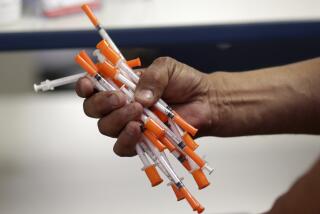Are Needle Exchanges a Forgotten Weapon in the War Against AIDS?
- Share via
President Clinton’s new six-point plan to combat the AIDS epidemic ignores an empirically proven measure to reduce HIV/AIDS: needle exchange programs.
Considering that one-third of all HIV/AIDS cases each year originate from intravenous drug use, needle exchange programs should be a focal point of any AIDS strategy. Congress, however, has banned federal funding for needle exchange programs. This ban and additional regulations are to remain in effect “. . . unless the surgeon general of the United States determines that such programs are effective in preventing the spread of HIV and do not encourage the use of illegal drugs.”
Unfortunately, Congress’ disapproval has influenced many state and local governments to take the same position.
But since 1992, scientific organizations, including the Center for Disease Control and Prevention, American Medical Assn. and Academy of Pediatrics, have endorsed lifting the ban. This raises the question: Why do many people and organizations, with the exception of a few key politicians and government officials, believe that needle exchange programs can significantly reduce HIV/AIDS rates?
It is because these concerned individuals and organizations know that needle exchange works. There are about 75 local programs in 55 cities across the United States as well as programs in other countries. Studies of these programs demonstrate that exchanging used needles for clean ones does not increase drug abuse or crime but does decrease HIV/AIDS rates.
Needle exchange programs also serve as an excellent mechanism for encouraging the drug addicts to seek treatment. Workers at these exchanges have direct, personal contact with the users and may be our best hope of reaching them.
Encouraging intravenous drug addicts to seek treatment is critical given recent pharmaceutical advances. Methadone treatment programs (which replace a heroin addict’s desire for heroin with methadone, a virtually harmless drug) are successful at stabilizing the lives of heroin addicts. Additionally, a new drug, Orlamm, is beginning to replace methadone and only has to be taken every other day as opposed to every day with methadone. A study by the National Research Council and the Institute of Medicine reports that the median cost of operating a needle exchange program is about $169,000 annually. The average lifetime cost for the treatment of one person infected with HIV/AIDS is $119,000, of which the government usually pays a significant portion. Clearly, exchange programs are a wise investment.
Why weren’t needle exchange programs mentioned in the AIDS strategy announced last month? The answer is obvious: They are a very political issue. The Clinton administration disregards program recommendations because it believes that dirty needles aren’t the problem; it’s the injection of illegal drugs. While a decrease in heroin use would reduce HIV/AIDS rates, this does not warrant ignoring needle exchange programs. President Clinton promised in the 1992 campaign that he would support needle exchange programs. He has the political capital to supersede the surgeon general’s suggestion and make one himself. An effective national AIDS strategy must include needle exchange programs.





